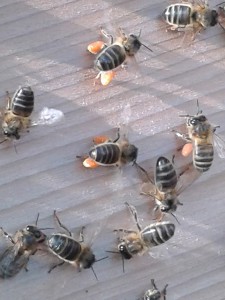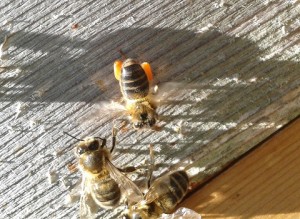Here’s an interesting one…
One of my apiary sites is in a nature reserve on a small raised bog in Kildare. The clover and blackberry are in full bloom all around the fringes there so I expected to find the bees with brown or grey pollen loads. However, I was surprised to find them bringing in a lot of vivid orange pollen and no, that’s not propolis. Of course I’d come out without my camera so had to make do with my phone and these pictures don’t do the colour justice. Click photos to enlarge.
When I consult the relevant pages of IBRA’s: ‘Colour Guide to the Pollen Loads of the Honey Bee’ by William Kirk, the only one I can find which is both close in colour and available in quantity at that site, is Poplar leaf rust fungus aka Melampspora larci-populina!
If you google that, you’ll find some images of the rust on its host species and you can imagine it packed into honey bee corbiculae.
It seems that the bees will indeed gather rust spores in times when pollen is in short supply. As the bees visit poplars to gather propolis you’d have to wonder if they help in the spread of this fungus?
Click here for more pollen load photos
Copyright © Beespoke.info, 2015. All Rights Reserved.



I’m having the same issue. Bees are gathering tree leaf rust by the hundreds.
Hi there,
I am a microscopist in London. I recently was given bee gut samples to image. we find in some bees a small structure that we can not agree what it is yet. it is either a parasite or a rust spore of some sort. I wondered if you could send me some of this rust ‘pollen’ next season to analyse for comparison?
By all means – if they do it again this year I will get some for you.
The only thing is – I’ve never seen that ‘pollen’ coming in before or since and I’m not certain that it was poplar leaf rust spores. I suppose the thing to do would be to get some poplar leaves infected with the rust and see if the spores match the stuff the bees were bringing in and the gut contents as well. Or better yet – The Forestry Commission Pathology Dept at Alice Holt should be able to help you – they probably have microscope images of Melampsora spores because it seems to be quite a pest! Contact details here http://www.forestry.gov.uk/fr/ddas
I’d love to see the images of the ‘small structure’ – is there a link to them?